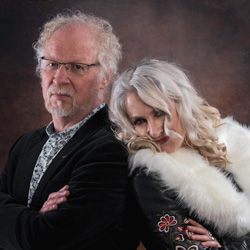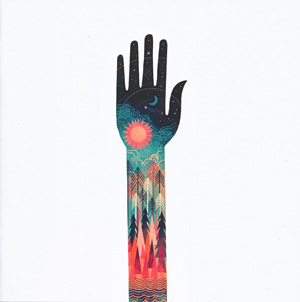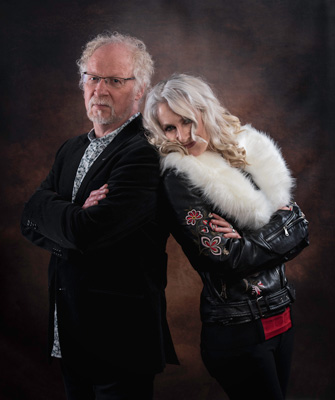 A SHOT IN THE DARK – interview with Jonathan Edwards & Rachel Cohen of Three Colours Dark
A SHOT IN THE DARK – interview with Jonathan Edwards & Rachel Cohen of Three Colours Dark
Reuniting former Karnataka members Rachel Cohen and Jonathan Edwards, Three Colours Dark recently released their remarkable debut album ‘The Science Of Goodbye’. With no major label hassling, or indeed any real game plan, as Jon is keen to stress throughout the interview, the pair got together “Quite by circumstance and very organically. There was no advance planning involved whatsoever. There’s a great deal of shared history, of course; we started writing music together in the late 1980s, and were two of the founding members of Karnataka, so we spent several years writing, recording and touring as a part of that band.
“But when the original line-up dissolved in 2004, we both went on to pursue successful separate music projects, Rach with The Reasoning and me with Panic Room and Luna Rossa. By the time The Reasoning disbanded in 2014, we’d pretty much lost touch with one another, and Rach took a few years out to focus on her career as an academic researcher. We met up at the end of 2018, just to have a casual chat and a catch up, and over a pre-Christmas beer we got to reminiscing – as you do! – about our respective music-related adventures over the years. Rach had begun to contemplate writing some new music by this point, but was unsure where to start in terms of finding new collaborators. I said I’d be happy to have a go at doing some writing together, and the rest is history. It became apparent very quickly that something really special was emerging, and we decided to go ahead, make an album and give our project a name.

“Everything came together remarkably quickly and smoothly right from the beginning, which is always a good sign,” he adds, “and the whole process was gentle, enjoyable and completely stress-free from start to finish. From that first discussion in the pub to the day that we sent the master for pressing, the album took just over a year to complete; and that included all the writing, recording, producing, mixing, mastering and artwork assembling.”
“The composition part of the project was very speedy,” Rachel confirms, “but that wasn’t a great surprise because we work well together as musicians, and already knew that we had a good affinity and connection as co-writers. We live in different parts of the UK, so we worked remotely at the beginning, with Jon sending me audio files of ideas that he was working on. I’d write some vocal melodies and some lyrics to go with them, and then we’d discuss how to further develop and build each song. Once we had a rough ‘draft’ of each track, I’d travel over to Jon’s home studio and we’d record a basic demo, which we could then embellish with additional arrangement parts as we went along. When we had an album’s worth of completed demos, we headed to Tim Hamill’s fantastic Sonic One Studios and got busy. We started off by laying down the basic framework of each song, and then gradually added extra instrumental parts and layers and additional and backing vocals as we went along.”
“We didn’t have a plan or musical agenda as such though,” recalls Jon. “We just let the music develop as we sparked off each other’s creativity. We both knew that we didn’t want the music to sound too much like any of our previous projects, although obviously when we write and perform, our musical personalities inform what we do, so there are certain elements, personal ‘quirks’ and methods of working, that will be present in all of our work, jointly or separately. But at the same time, it also felt like a fresh start and it was a pleasure to rediscover the joy of working together. When you collaborate with someone it’s important to leave them the space to develop their own responses to the music and at its best that process can be a creative chain reaction that feels entirely natural and unforced. When it works well, you produce something that feels like a true collaboration, making music that wouldn’t exist without both partners, and that’s certainly been the case with ‘The Science Of Goodbye’.”
I wondered if there was a fear that people would look at the names behind Three Colours Dark and have an instant expectation as to what the album would sound like. Or maybe that was perhaps one less pressure? “One of the greatest and most important lessons in life is to accept gracefully that you have no control over how other people think or behave,” notes Jon, “and we’ve both been in the world of music for long enough to have a very comprehensive grasp of that one! It had been nearly fifteen years since our collaboration as part of Karnataka, and we’d both done plenty of other music-related work in the elapsed time, so we had absolutely no desire to try and replicate or conform to any of those past endeavours, and we didn’t see any reason why the music and the project shouldn’t have an identity of its own. It was lovely to be able to write together with no particular plan, no rules or objectives, and no deadlines; the creative freedom that comes with that is wonderful. We chose to keep the project secret until it was finished, which meant that no one had the opportunity to form any expectations about it, either.”

I presumed that the name came as a spin on the ‘Three Colours...’ film trilogy of the Nineties, but was a mile off the mark with that one. “No, the song came first,” says Rachel, “and we later decided to make that the band name as well. But you presume incorrectly about its inspiration and origins, although – given that we’re both lifelong film enthusiasts – we’re of course aware of the cinematic ‘nod’, as it were, and it seems like a relevant association to make, since some of our soundscapes are quite cinematic as well. But ‘Three Colours Dark’ is actually a reference to the ‘dark triad’ personality profile; a term that was coined in a research paper in 2002 by Paulus and Williams and which refers to three unusually negative personality traits: narcissism, Machiavellianism and psychopathy.
“My inspiration for lyrics comes from multiple sources, and not just from my own life experiences,” she continues. “I tend to write about relationships – our relationships with ourselves and with others – and about identity more generally. I’ve also been interested in the topics of narcissism, narcissistic personality disorder (NPD) and narcissistic abuse, a very damaging form of psychological and emotional abuse, for many years, and those are certainly explored in some of the lyrics on this album. We have a collaboration project set up with The Echo Society UK – an organisation that runs workshops, provides peer support and a counselling service for people who are affected by narcissistic abuse, and with whom I had an existing professional connection. Many of the lyrical themes on our album are relevant to the wonderful work that they do, and I think that music can be very powerful in offering reassurance and comfort to people dealing with difficult or painful emotional experiences. I also felt that it was important to provide a direct signpost to a source of (formal) professional support, should people need it. You can read about the collaboration here: https://www.theechosociety.org.uk/three-colours-dark "
By now you’ll probably have realised that ‘The Science Of Goodbye’ isn’t quite as straightforward as it may seem, and there aren’t many releases that come equipped with a reading list. “I wish more albums offered fully referenced reading lists!” Rachel points out. “Yes, I have fully embraced my inner nerd with Three Colours Dark and wanted to share that with anyone who felt so inclined. I am an academic by profession and have worked as a lecturer and a researcher since completing my PhD in 2013, so my studies and my research career are a big part of my life. I have multiple areas of interest and expertise, all of which inform my lyric-writing in some way, and the reading list reflects many of those. I also write a weekly blog, in which I take a similarly nerdy approach to writing about my autobiographical experiences as a musician: https://thewallsofwonderland.wordpress.com/ ”
To help the duo bring ‘The Science Of Goodbye’ to fruition Jon and Rachel enlisted the help of a handful of guests. “We knew from the start of Three Colours Dark that since there were only the two of us we’d need certain instrumental elements that we wouldn’t be able to provide by ourselves,” Jon clarifies. “We’re keen to emphasise that Tim Hamill is very much the third ‘unofficial’ member of the band. As well as being a superb studio engineer and producer, he’s also a very talented musician, and his involvement has been invaluable in bringing ‘The Science of Goodbye’ to life, both in terms of playing various instruments and helping to refine the song arrangements as well. You’ll hear him playing acoustic guitar, electric guitar and bass guitar on the album, and he also created and programmed all of the drum tracks and percussion loops.
“There were also some sounds and textures that we sought further afield, though, and what we wanted from our guest musicians was for them to bring their own ‘personalities’ to the songs. Some of them came into the studio to record their parts while others were sent the music and recorded their contributions in their own home studios. We then added any additional vocal or instrumental sections inspired by the new parts our guests had played and Tim completed the mix.”

The rollcall of contributors lists Dave Gregory (XTC / Big Big Train), Chantel McGregor, Kate Ronconi, Nathan Bray and Steve Balsamo. “‘Ghosts in the Wind’ is a Richard Thompson track that I’d loved for years,” explains Jon. “I’d always fancied covering it at some point, but the context had never been right with any of the albums I’d made. But as the songs for the Three Colours Dark album emerged I realised it really seemed to fit lyrically with the album’s themes and I knew we could arrange it in a way that would fit with the overall vibe of the album. I’d met Dave Gregory a couple of times, he’s a really lovely guy as well as a talented musician, and I just thought he’d be the perfect player to create something special on the song. It was just a matter of inviting him to do it – I was delighted when he agreed! – and I love everything that he did with the track. He ‘got’ exactly what we wanted to do with the song and his contribution is so atmospheric and haunting… Just what it needed.”
Unlike Dave, the pair hadn’t met Chantel McGregor, “but we’d admired her playing for a while,” Jon recalls, “and with the bluesy feel of ‘Blood Moon Rising’ we thought she could bring her soulful style and sensual feminine energy to the song. The result is gorgeous, and really adds to its emotional textures. Kate Ronconi, on the other hand, we already knew through our mutual music connections, and were familiar with her successful folk-pop band Rag Foundation. Although a couple of violin melody parts were written in advance, the majority of the lines that Kate plays on the album were her own ideas, and much of it was improvised during our studio sessions. It’s such a joy to watch musicians creating in ‘real time’ like that, especially when they’re doing so as part of a song you’ve written. For me, Kate’s violin is like a silver thread that runs through the album and ties a lot of the music together. And Nathan Bray is a session brass player that we found online. His CV is extensive and impressive, and he’s performed and recorded with many artists in the jazz and pop/rock worlds. We sent him the songs, and he returned them to us with numerous trumpet and flugelhorn parts for us to choose from. A true professional, and every take was brilliant and unique. We had real trouble making our final choices, and we’re really pleased with what Nathan has brought to the songs.”
“And I’ve known about Steve Balsamo and his awesome voice for many, many years,” adds Rachel. “We moved in similar-ish musical circles in South Wales in the late Eighties and early Nineties but had never actually met in person. On this album, I was keen to add some male vocals to ‘Wonderland (How Can This Be Love?)’. I’d envisaged the lyrics over the bridge section as a dialogue between thoughts and feelings, left-brain and right-brain processes, and the experience of cognitive dissonance, and thought this would work well as a duet. Steve is a long-time friend of Tim’s, and so we were lucky to have our invitation to him made less formally! Despite originally only intending to focus on that one song, the studio chemistry was so great that Steve kindly sang some additional vocals on another three songs as well. He has one of those voices that makes you – well, me!,” she laughs – “weak at the knees, and is unquestionably one of the most talented singers I’ve ever worked with. Steve hadn’t heard any of the music beforehand, but connected with it immediately on a musical and emotional level, and it was really exciting to work with him. He’s also a super lovely person, which helps!”
The future for Three Colours Dark is an unwritten book at this point in time. “Since we didn’t begin with any specific game plan, I think we’ll just see how it goes,” says Jon, simplify. “We’ll keep making music together for as long as we enjoy doing so. We loved making the album, and have been delighted with the enthusiastic reviews and the warm welcome that it’s received so far. We had many ideas that didn’t make it on to this album, and I think it’s safe to say that there won’t be any shortage of inspiration or enthusiasm in that department for the foreseeable future. We don’t have any immediate plans for live performances, primarily because we don’t have a band assembled at this point. But we have discussed the possibility of perhaps organising a handful of full-scale live shows, though, so never say never!”
© John Tucker June 2020
